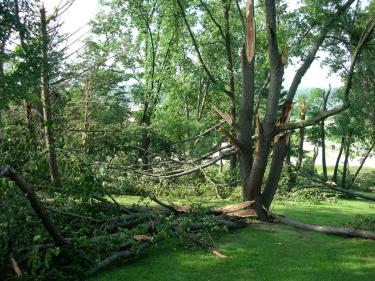What to do After a Windstorm
Surveying the damage and salvaging what you can is key after a windstorm.
The first step in helping your woods recover from a windstorm is assessing how much damage they sustained. Make sure to:
- Stay safe. Strong winds and blown down trees can topple power lines, block access roads, or otherwise create safety hazards. Stay clear of any potentially dangerous areas.
- Get help. Ask a professional forester to help you assess the damage to your woods. Some windstorm damage can be hard to spot—or, in the case of breakage or blow-over, hard to manage and remove on your own.
- Survey your woods—carefully. Be very careful as you go out among your trees and take stock of the damage. Take detailed notes and photographs, if possible, to document the damage. To determine how severe the damage is, ask yourself:
- Are the tree’s major limbs broken? In particular, have the stem or the leader (the main upward-trending branch) been broken?
- Is at least 50 percent of the tree’s crown—its branches and leaves—still intact?
- How big are the tree’s wounds?
As a general rule, the larger the wound or broken limb or the more extensive the damage to the crown, the lower the tree’s chance of survival and recovery. Your forester can help you answer these questions and determine what they mean for your woods.
- Salvage ASAP. Broken, uprooted or profoundly damaged trees should be salvaged promptly. Some of these trees—particularly log-sized ones (12 inches in diameter or more)—may find interested buyers; very badly damaged trees may be removed at a loss. Your forester can help you plan a safe, economically sound salvage.
When salvaging:
- Avoid delays—insect pests, such as bark beetles, are more likely to show up when salvage isn’t prompt.
- Make salvaging pines a priority, as they are more susceptible to pest outbreaks. Hardwoods can follow.
- Be careful not to damage remaining, intact trees during removal.
- Protect the survivors. During your forest’s recovery period, manage the affected areas carefully and protect them from stress. Damage from windstorms leaves your woods vulnerable to wildfire, disease, insects and invasive species, even after broken trees and debris have been removed.
- Watch it. Keep an eye out for pest activity or abnormal growth—for example, a twisting stem or lopsided crown—for up to two years following the windstorm. Damage isn’t always immediately apparent after a storm.
It may not be possible to shield your woods from a windstorm’s damage, but it is possible to prepare. A healthier, more resilient forest will stand a better chance of survival, no matter what the weather brings.
Previous page
Next page
How can I get more tips?
It’s simple! Enter your email below.

